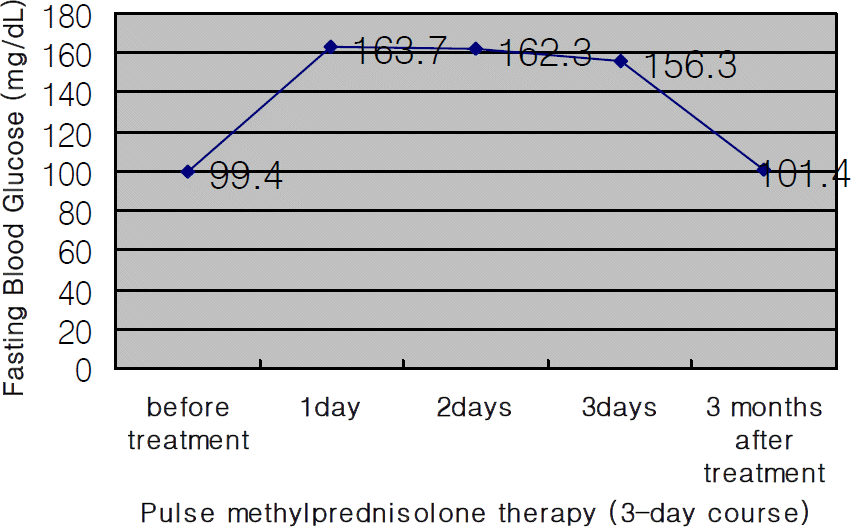Abstract
Purpose
To determine the side effects of short-term high-dose methylprednisolone therapy (pulse methylprednisolone therapy), which was used to treat patients with optic neuritis, traumatic optic neuropathy, orbital pseudotumor, and orbital myositis.
Methods
All 27 patients treated with pulse methylprednisolone therapy from June 2005 to June 2006 were included in this study. Each patient was injected with 1 g per day of methylprednisolone intravenously, administered in 250 mg doses every 6 hours, for 3 days. We measured body mass index (BMI), fasting glucose, HbA1c, blood pressure, and intraocular pressure. In addition, we performed slit lamp examination and chest X-ray.
Results
The average age of the 27 patients was 35.8 years, including 16 males and 11 females. Thirteen patients had optic neuritis, 10 patients had traumatic optic neuropathy, 3 patients had orbital pseudotumors, and 1 patient had orbital myositis. Before treatment, the average of body mass index (BMI) was 23.09 (kg/m2), but at 3 months after treatment it was 23.73 (kg/m2). All patients had fasting glucose levels higher than the normal range during the treatment. However, all fasting glucose levels returned to within the normal range at 3 months after treatment, except in 1 patient. In addition, a major complaint among patients was an increase in body weight.
Conclusions
We performed a close observation of controlled diet and exercise on patients who were treated with pulse methylprednisolone therapy because we knew it would have a hyperglycemic effect. An increase in body weight is the most common complaint of steroid therapy. Even after treatment is completed, it is important to monitor glucose level and weight.
Go to : 
References
1. Boumpas DT, Chrousos GP, Wilder RL, et al. Glucocorticoid therapy for immune-mediated disease: basic and clinical correlates. Ann Intern Med. 1993; 119:1198–208.
2. Sabir S, Werth VP. Pulse glucocorticoid. Dermatol Clin. 2000; 18:437–46.
3. Beck RW, Cleary PA, Anderson MM, et al. The Optic Neuritis Study Group. A randomized, controlled trial of corticosteroids in the treatment of acute optic neuritis. N Engl J Med. 1992; 326:581–8.
4. Wakefield D, McCluskey P, Penny R. Intravenous pulse methylprednisolone therapy in severe inflammatory eye disease. Arch Ophthalmol. 1986; 104:847–51.

5. Lam DS, Wong AK, Tham CC, Leung AT. The use of combined intravenous pulse methylprednisolone and oral cyclosporin A in the treatment of corneal graft rejection: a preliminary study. Eye. 1998; 12:615–8.

6. McMahon M, Gerich J, Rizza R. Effects of glucocorticoids on carbohydrate metabolism. Diabetes Metab Rev. 1988; 4:17–30.

7. Pandit MK, Burke J, Gustafson AB, et al. Drug-induced disorders of glucose tolerance. Ann Intern Med. 1993; 118:529–39.

8. Baethge BA, Lidsky MD, Goldberg JW. A study of adverse effects of high dose intravenous (pulse) methylprednisolone therapy in patients with rheumatic disease. Ann Pharmacother. 1992; 26:316–20.
9. Feldman-Billard S, Lissak B, Benrabah R, et al. Intravenous pulse methylprednisolone therapy in eye disease: effect on glucose tolerance. Ophthalmology. 2003; 110:2369–71.
10. Cupps TR, Fauci AS. Corticosteroid-mediated immunoregulation in man. Immunol Rev. 1982; 65:133–55.

11. Fan PT, Yu DT, Clements PJ, et al. Effect of corticosteroids on the human immune response: Comparison of one and three daily 1-gm intravenous pulses of methylprednisolone. J Lab Clin Med. 1978; 91:625–34.
12. Melby JC. Clinical pharmacology of systemic corticosteroids. Annu Rev Pharmacol Toxicol. 1997; 17:511–27.

13. Bell PR, Briggs JD, Calman KC, et al. Reversal of acute clinical and experimental organ rejection using large doses of intravenous prednisolone. Lancet. 1971; 1:876–80.

14. Feldman-Billard S, Lissak B, Kassaei R, et al. Short-term tolerance of pulse methylprednisolone therapy in patients with diabetes mellitus. Ophthalmology. 2005; 112:511–5.

15. Badsha H, Edwards CJ. Intravenous pulses of methylprednisolone for systemic lupus erythematosus. Semin Arthritis Rheum. 2003; 32:370–7.

16. White KP, Driscoll MS, Rothe MJ, Grant-kels JM. Severe adverse cardiovascular effects of pulse steroid therapy: is continuous cardiac monitoring necessary? J Am Acad Dermatol. 1994; 30:768–73.

17. Lyons PR, Newman PK, Saunders M. Methylprednisolone therapy in multiple sclerosis: a profile of adverse effects. J Neurol Neurosurg Psychiatry. 1988; 51:285–7.

18. Renoux M, Hilliquin P, Menkes CJ. Bolus of methylprednisolone in rheumatic practice. Ann Med Interne. 1994; 145:133–9.
19. Koistinen MJ. Prevalence of asymptomatic myocardial ischemia in diabetic subjects. BMJ. 1990; 301:92–5.
Go to : 
Table 1.
General characteristics of patients
| Age (years) | 35.8 +/- 17.9 |
|---|---|
| Gender | |
| Male | 16 |
| Female | 11 |
| Disease | |
| Optic neuritis | 13 |
| Traumatic optic neuropathy | 10 |
| Orbital pseudotumor | 3 |
| Orbital myositis | 1 |
Table 2.
Differences between before and after the treatment by paired t-test




 PDF
PDF ePub
ePub Citation
Citation Print
Print



 XML Download
XML Download